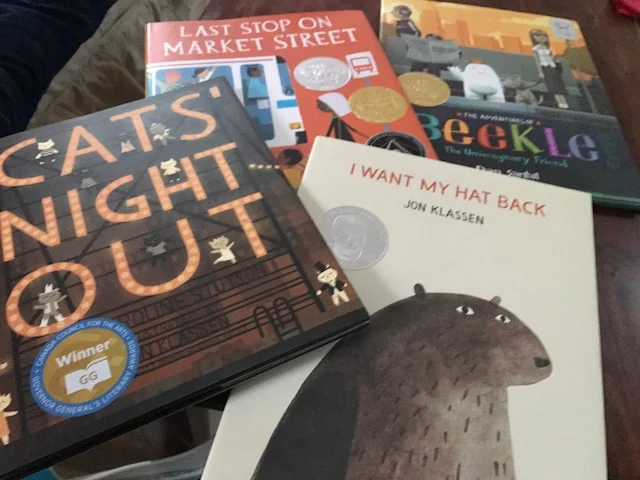I've been reading and studying 100 picture books from the last five years to learn how to write them. I've been recording my findings using the hashtag #100picturebooks.
This is what I’ve learned so far…
1. My favorite picture books tend to start conversations, not preach. I love subtle prompts within the stories that encourage children (and their adults) to ask questions, think, and explore.
2. I also love books that don’t speak down to children, whether it’s with words or with visuals. Vocabulary and sophisticated writing are things to celebrate, and little subtleties in the illustrations are usually noticed and noted—it might be during the first reading or the twelfth.
3. It’s not just about word count. It’s also about how you decide to spend them throughout the story.
Action sequence from ON A MAGICAL DO-NOTHING DAY by Beatrice Alemagna
4. Never underestimate the power of a dramatic page turn and a full spread illustration with minimal words.
5. Illustrations are like words. They layer the story, allowing the writer to tell more with less writing.
6. Repetition is a powerful tool, whether it’s a phrase or a layout style. The power of three is alive and kicking in the world of picture books.
7. Elements from comics and graphic novels are working their way into picture books. Speech and thought bubbles are great for managing dialogue with an ensemble cast of characters, and a comic-strip layout can streamline and effectively communicate complicated scenes.
New school, new language in I'M NEW HERE by Anne Sibley O'Brien
8. The words might be your baby, but the book is actually everyone’s baby. Once you have written, polished, and nurtured the story, let it go. Push it out of the nest and let it fly at the hands of the illustrator, editor, and book designer. The end product is everyone’s to celebrate, and collaboration will bring new life and dimension to the story.
9. Page count and word count are complex things. I’m still trying to figure them out. As you look through successful picture books, you will find many discrepancies to “the rules.” There are books that break that 32-page format that everyone talks about, and some picture books have many, many words or none at all. I think it’s important to see “the rules” at work in the heart of every picture book, and identify why the decisions were made to evolve the format to best tell the story. There appears to be wiggle room, problem solving, and numerous decisions made throughout the evolution of the story and the creative process.
10. It’s valuable to mock up your words into a book format, though you know you will never ever show it to anyone. When I thought I was done, I did this, and was surprised at how useful it was for the pacing and arc of the story. Getting it to fit in the given structure was an odd challenge, and I identified areas where I might need rework to quicken or slow the pace.
That moment before the big splash in JABARI JUMPS by Gaia Cornwall
11. When you can, engage all the senses. Some stories are void of senses and are highly effective, others use the senses to add richness and depth.
12. Some books use words to guide what the reader sees in the illustration. If there are nuanced details or actions in the images that are key to the story, an author can highlight them with the writing in creative ways. The reverse is also true. I love a book that has a detail in the background that is not called out, but is there from the start. It is magic when its meaning and importance is revealed at the end.
13. From the cover to the pattern on the end papers to the author flap at the back of the book, I love books that use every corner to tell the story.
14. Personally, I only talk about and highlight the books I love and appreciate, but as I read more and more picture books, I see some rising to the top. I am pooling the ones that I really connect with as a writer, the ones that seem to be most like what I’m trying to do with my writing, voice, and style. Having a long list of favorites that are diverse in style, language, and thought are important, but also keep a smaller curated list of titles and authors that you identify with as a writer.
15. When you stumble upon a book that just doesn’t resonate with you, try to analyze it and figure out why you think it was published and what makes it effective. I find that when I deconstruct and study the elements that make a title tick, I can usually find a new appreciation for what makes it work.
Happy reading and writing!




